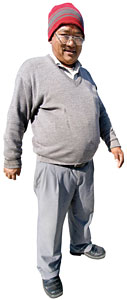|
|
After binging during the Dasain festival, many urban Nepalis are examining their girth and are trying to figure out a way to work it off.
Nearly 40 percent of Nepali children may be underweight, but being overweight is also becoming a serious health hazard in Nepal. In a way it reflects society's inequities, but it goes beyond that: lack of awareness about a balanced diet, the advent of junk food, society's increasingly sedentary lifestyle. The middle class is getting a wider middle.
A visibly overweight patient with diabetes and hypertension was being checked up recently at a Kathmandu hospital by an obese cardiologist. The patient was overheard telling relatives later, "Looks like he doesn't follow his own advice."
While walking in remote Mustang last year, I used to ask for millet chapatti and beaten rice for my meals. My 19-year-old guide and porter was embarrassed-it hurt his reputation that his employer ate local food and not packaged instant noodles.
Across Nepal, from Mustang to Mahendranagar, the changing food habits of Nepalis are leading to many health problems. Obesity and related cardio-vascular diseases are among them. In the villages, it is still rare to see overweight people and that is simply because they have to walk and work in the fields.
But even there, the spread of roads and bus transportation means people are getting less exercise. Combine this with an increased carbohydrate intake and you have a recipe for fat buildup. In Kathmandu and other urban areas, obesity has now become an epidemic. Till a generation ago, being overweight was regarded as a sign of prosperity. Today it points to potentially serious health problems.
Cardiologists I know obviously don't practice what they preach. They are themselves overweight, suffer from high blood pressure, and have borderline diabetes. Another colleague who regularly advises his patients to practice yoga fails to do so himself, although he seems to need it more than his patients.
In countries like India and China, obesity was virtually unknown until the introduction of a high-fat, western-style diet. With a per capita income of $7,700, China is facing an unprecedented health crisis due to obesity among youngsters. Public health specialists in India are worried that changing food habits may have exacerbated the genetic proclivity of many Indians to cardio-vascular diseases.
In order to make food tasty, we use a lot of oil and then consume too much of it. In addition to that, we drink lots of sodas, and eat snacks, packaged food and other highly processed, sweet, high-fat foods. We end up feeling nauseated because of over eating, and then go to health workers to ask for digestive medicines. This habit is passed on to our children who may later develop heart problems, diabetes, and high blood pressure.
'We are what we eat' is one of those truisms that couldn't be truer. What you ingest directly affects your health. What comes in the way is our most primal instinct: to have our taste buds stimulated. The trouble is, the tastiest foods are also the most harmful: deep fried items, fatty foods, refined carbohydrates, salty snacks, etc.
It is only when patients get their first stroke or heart attack that they decide to change their food habits. Unfortunately, for some even such a warning is not enough and they go back to their unhealthy eating habits.




